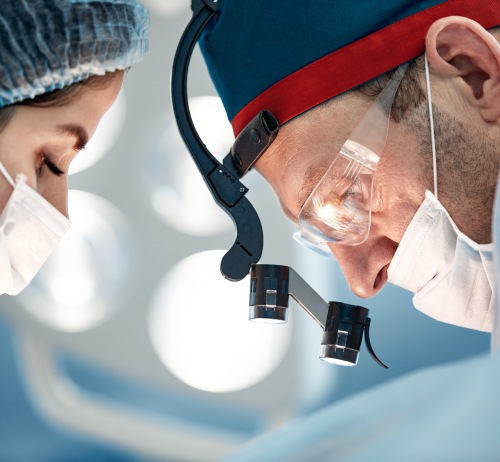Bartholin's Gland Cyst Removal
The Bartholin's glands are located below the vagina on both sides of the labia majora. Their function is to secrete a moisturizing fluid during arousal. If they become inflamed, cystic growths can form. The development of a cyst causes discomfort in the perineum and can cause pain during intercourse.
The K+31 Clinic (Moscow) diagnoses and treats gynecological conditions of varying complexity. The use of modern minimally invasive surgical techniques allows for the effective removal of growths and shortens recovery times.

specialists

equipment

treatment

Indications for surgery
Surgical removal of cysts 3 cm or larger in diameter is recommended. Indications include physical discomfort from the growth and the woman's desire to restore the aesthetic appearance of her genitals.
If the cyst has developed into an abscess, prompt removal helps prevent the development of sepsis. Surgery can correct the pathology and restore the function of the Bartholin's glands.

Contraindications to surgery
Surgery is not performed if the patient has:
- Decompensated diabetes
- Severe autoimmune pathologies
- Bleeding disorders
- Genital infections
Surgery is also not prescribed during pregnancy and lactation.
In the event of an exacerbation of chronic diseases and inflammatory processes, treatment is performed first, followed by surgery.

Symptoms and Diagnosis
In the early stages, there is no discomfort; the problem can only be detected during a routine gynecological examination.
Over time, the size increases, causing the following symptoms:
- Asymmetry of the labia majora
- Swelling of the cyst and swelling during exacerbations of upper respiratory tract or pelvic infections
A large tumor blocks the vaginal opening and causes pain during intercourse or while sitting.
Upon palpation, a woman may detect swelling on one side. The tumor is soft to the touch and has well-defined edges.
If a cyst forms on both glands simultaneously, lubrication during sexual intercourse stops, causing dryness and pain. This symptom does not occur with a unilateral tumor.

Causes and Types of Bartholin's Gland Cysts
Women are susceptible to this condition at the peak of their sexual activity, usually before age 30. This is because the glands secrete fluid during sexual arousal; the more frequently this occurs, the more fluid is produced.
If the ducts become blocked, the secretion is blocked, leading to accumulation and cyst formation. This can occur for a number of reasons:
- Rupture of the perineal tissue due to trauma, childbirth, or surgery on the labia or vagina
- Chronic inflammatory diseases of the genitals caused by bacteria (cocci, chlamydia, E. coli)
- Acute Bartholinitis
Infections cause changes in the tissue structure of the Bartholin glands. As a result, swelling occurs, the duct walls thicken and become encapsulated, and the secretions inside gradually thicken.
Bartholin's cysts can be unilateral or bilateral, single-chambered or multi-chambered. The disease is divided into two severity levels: complicated and uncomplicated.
Treatment and Cyst Removal Methods
Conservative Treatment
A cystic growth does not resolve on its own without surgery. Although it is hormone-dependent, it is not treated with hormonal therapy. In cases where the cyst is small, the doctor recommends monitoring its growth. Once the cyst reaches 3 cm in diameter, surgery is recommended.
Surgical Treatment
Several types of interventions are possible, including extraction of the cyst contents through new ducts or by vaporization, as well as removal of the tumor itself. The choice of method depends on the progression of the disease and the presence of complications. In most cases, doctors try to preserve the gland and restore its functionality.
In modern clinical practice, the technique of incising the tumor and then draining it has lost popularity due to the high risk of recurrence. Doctors are now choosing more effective and safer treatment options. Puncture techniques are used only in patients for whom surgical intervention is contraindicated.
Removal techniques

Let's look at several popular methods for removing a Bartholin gland cyst.
Inserting a Word Catheter
This method allows for the cyst contents to be aspirated and a new channel to drain the secretions. It helps eliminate the pathology and preserve the gland.
Surgical Procedure:
- The doctor makes a skin incision to open the cyst capsule.
- Fluid removal and gland irrigation.
- Insertion of a catheter into the gland cavity. This catheter is a thin silicone tube with a dilator and a balloon at the end, extending into the vagina.
- Soft tissue suturing.
The catheter should be in place for 6 weeks. During this time, the gland contents will drain into the catheter cavity, while a new channel will be formed. After this, the tube is removed.
This method is minimally invasive. Pain disappears within 6 days after the surgery.

Jacobi Ring Placement
This method is used when it is not possible to insert a Word catheter, for example, in the case of an abscess. This technique also involves the creation of a new duct. During the surgery, the surgeon makes two punctures in the cyst, inserts a rigid tube through them, and connects it into a ring. The duct is formed over the course of 5 weeks.
Marsupialization Method
This method is suitable for small cysts or cysts with multiple chambers, as well as in cases where inserting a catheter is not possible. As with previous techniques, it involves the creation of an alternative duct to drain secretions from the gland.
Procedure:
- The surgeon makes an external skin incision to provide access to the cyst.
- Cyst dissection. Removal of its contents from the cavity and irrigation.
- Suturing the edges of the incision, folding them in different directions. The surgeon grasps the cyst wall and mucosa on each side, then connects them with sutures.
During the surgery, an open opening is created in the gland's capsule, through which the secretions flow.

Laser Vaporization
A minimally invasive cyst removal technique that uses a laser beam instead of a scalpel. The surgeon makes an external incision to open the cyst capsule. The surgeon rinses its contents and, using a light beam of a specific length, vaporizes the cyst walls. During the surgery, the doctor removes only the cyst, sparing healthy gland tissue.
This method is bloodless and eliminates the risk of infection, as small blood vessels are immediately "sealed" by the high temperature during tissue dissection.
Gland Extirpation
A surgical procedure performed in a hospital setting under general anesthesia. It involves the removal of the Bartholin's gland along with the cyst, and is most often used in cases of abscess formation. It is important to remove the entire gland during the surgery, as it can cause a cystic lesion. If tissue fragments remain, there is a risk of recurrence and suppuration, leading to the formation of a rectovaginal fistula.
Resection is the most complex of the possible cyst removal methods and requires a longer recovery period.

Stages of Preparation for Surgery
Preparation for surgery includes:
- Visual examination of the patient on a gynecological examination table
- Testing
- Instrumental diagnostics (pelvic ultrasound)
Laboratory tests of blood and a vaginal swab are performed to detect viral infections. It is also necessary to sample the cyst contents to determine the presence of pathogenic microflora. In the absence of complications, even with negative vaginal culture results, the cyst contents will be free of microbes.
Before hospitalization, testing for syphilis and antibodies to hepatitis B and C is often required. If cancer is suspected, a cyst biopsy is performed. This may be a mandatory step in the evaluation of menopausal patients.
Post-operative Recovery
How long does recovery take?
Recovery after minimally invasive catheter insertion or laser vaporization takes 1-1.5 months; in the case of removal of a gland with an abscess, recovery takes up to 3 months.
Post-operative restrictions
During the entire recovery period (4-6 weeks), the following is prohibited:
- Swimming in open water or bathtubs (showers are permitted only)
- Overheating, visiting baths or saunas
- Physical activity and sports
- Weight lifting
- Sexual intercourse
Important! If bleeding, pain, or swelling occurs that does not subside within 3 days, consult a doctor.
Care and hygiene
During the postoperative period, the perineum should be treated with antibacterial agents until the wound heals. Wash with hypoallergenic soaps. Liquid intimate soap or baby soap labeled 0+ are suitable. Wear underwear made of natural fabrics.
General information
FAQ
Should a Bartholin's gland cyst be removed?
This condition is not treatable with medication and does not resolve on its own. Surgery is required to remove the cyst. In the early stages, without complications, removing the fluid from the cyst and inserting a temporary catheter is sufficient.
Is anesthesia necessary for Bartholin's gland cyst removal?
Minimally invasive procedures involving drainage catheter placement or laser vaporization use local anesthesia. General anesthesia is required for Bartholin's gland removal.
What's the danger of a Bartholin's gland cyst?
If left untreated, the cyst will grow in size and can reach 10 cm in diameter. If a bacterial infection develops, inflammation, abscess, and sepsis with blood poisoning are possible.

This award is given to clinics with the highest ratings according to user ratings, a large number of requests from this site, and in the absence of critical violations.

This award is given to clinics with the highest ratings according to user ratings. It means that the place is known, loved, and definitely worth visiting.

The ProDoctors portal collected 500 thousand reviews, compiled a rating of doctors based on them and awarded the best. We are proud that our doctors are among those awarded.
Make an appointment at a convenient time on the nearest date
Price
Other services




















































What is a Bartholin's gland cyst?
A cyst is a hollow formation containing fluid. It typically does not develop into a malignant tumor, but without treatment, there is a risk of complications such as bartholinitis, suppuration, and tissue abscess.
A Bartholin's gland cyst appears as a round, soft bulge located at the base of the labia. It can reach up to 10 cm in diameter. It forms when the gland's ducts become blocked, with subsequent encapsulation of the secreted fluid. This pathology is rare, occurring in approximately 2% of young women.